#indian bread pudding
Photo

Shahi Tukra Indian Bread Pudding
In this dessert recipe from Hyderabad, India, fried cashews, almonds, and pistachios cover deep-fried bread that has absorbed a milk sauce seasoned with saffron and cardamom. 1/4 cup sliced almonds, 1.25 cups whole milk, 8 slices white bread crusts removed and cut into 4 squares, 5 tablespoons evaporated milk, 1 pinch saffron, 1/4 cup cashews, 3/4 cup white sugar, 1 quart oil for deep frying, 2 tablespoons pistachio nuts, 1 teaspoon ground cardamom
1 note
·
View note
Photo

Shahi Tukray Indian Bread Pudding Recipe
In this Indian bread pudding known as shahi tukray, slices of bread are deep-fried, covered in sweetened condensed milk, and baked until golden. 1 quart half-and-half, oil for frying, 1 loaf sliced bread crusts removed divided, 1 can sweetened condensed milk, 2 cups white sugar
0 notes
Photo
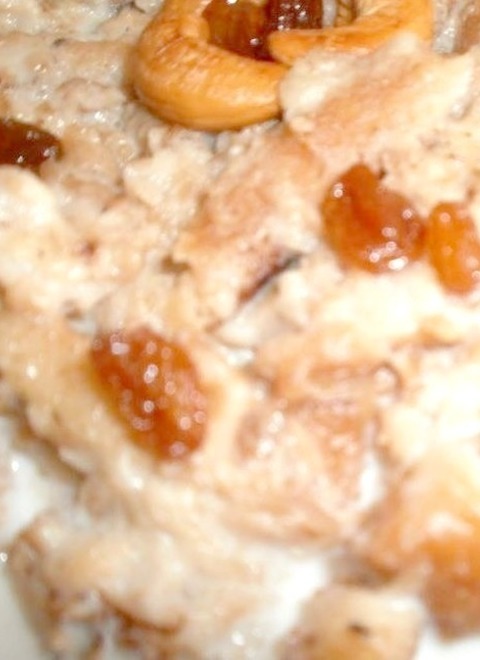
Recipe for Indian Bread Pudding Double Ka Meeta
Pan-fried bread slices are dipped in a cardamom-scented syrup and simmered with milk, raisins, and nuts for a richly delicious Indian-style dessert.
0 notes
Photo

Indian Bread Pudding Double Ka Meeta
For a decadently tasty Indian-style dessert, pan-fried bread slices are dipped in a cardamom-scented syrup and simmered with milk, raisins, and nuts.
0 notes
Photo

Shahi Tukray Indian Bread Pudding - Cuisine
Slices of bread are deep-fried, soaked in sweetened condensed milk, and baked until golden in this Indian bread pudding called shahi tukray.
0 notes
Photo
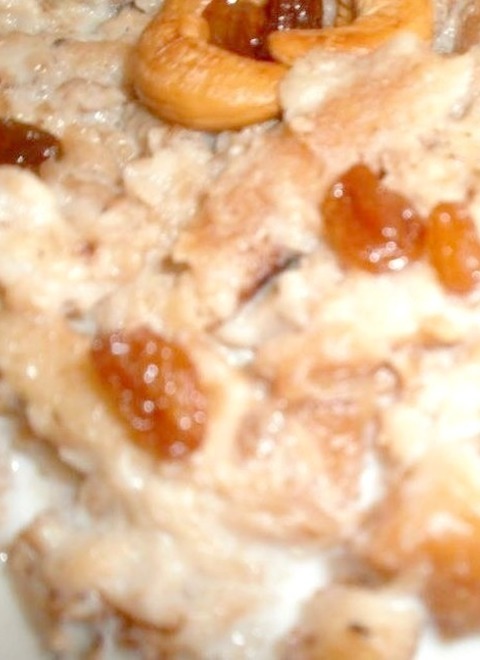
Indian Bread Pudding Double Ka Meeta
Pan-fried bread slices are dipped in a cardamom-scented syrup and simmered with milk, raisins, and nuts for a richly delicious Indian-style dessert.
0 notes
Photo

Shahi Tukray Indian Bread Pudding
In this Indian bread pudding known as shahi tukray, slices of bread are deep-fried, covered in sweetened condensed milk, and baked until golden.
0 notes
Text
Shahi Tukda
Shahi Tukda
Shahi Tukda is a traditional sweet recipe which is prepared by frying the bread pieces in ghee and immersing it in a rabdi made of milk. This is a simple and best Indian dessert which everyone can easily try at your home.
This sweet dish is originated from the Nawabi cuisine. Today, shahu tukda is associated with most of the wedding parties, marriage receptions and diwali as the…

View On WordPress
#bread and milk#bread pudding recipe#bread recipes#easy bread pudding recipes#Indian bread pudding#Royal bread pudding#shahi toast#shahi tukda
1 note
·
View note
Text
Double ka Meetha
Double ka meetha is a traditional Indian dessert made using bread. This nawabi sweet is also called as an Indian bread pudding. Double ka meetha is basically fried bread dipped in freshly made caramelised sugar syrup. In Hyderabad, this dish is a very popular dessert. You might be familiar with another popular Indian sweet “Gulab Jamun”. This sweet bread pudding also uses the same process as…

View On WordPress
0 notes
Text
HETALIA SMELL HEADCANONS (I worked super hard on this, so pls look at it, appreciate it, and reblog? esp with comments bc i love seeing ur comments ^u^)
N. Italy: Garlic-flavored armpits
Germany: Normally, he just smells like sugar and cinnamon.
Japan: Rainwater
America: Hot dogs and bacon
England: Nosebleeds
Fr*nce: cheese
China: Braised pork belly and warmth
Russia: A mixture of booze and warmth
Canada: Poutine
Belgium: Chocolate chip waffles with a hint of strawberry
Luxembourg: Blackberrie-scented cologne
Netherlands: Money
Austria: Rose-scented perfume
Hungary: Warmth and fresh bread
Liechtenstein: https://www.fragrantica.com/perfume/Sanrio/Hello-Kitty-71771.html
Poland: Cream soda
Prussia: Snow cones
Slovakia: Fresh-baked cheesy bread
Switzerland: Goat milk
Estonia: TV static
Latvia: Hot cocoa & cookies
Lithuania: Lithuania.
Belarus: Mint
Bulgaria: He smeel like he boozin' & loosin'
Moldova: Halloween candies & cheese puffs
Romania: Red-flavored kool-aid
Ukraine: Fresh-baked blueberry bread and warmth
Denmark: Hairgel
Finland: Christmas!!!!!!!!!
Iceland: Hot cocoa & cookies
Norway: Fish-flavored snacks
Sweden: Coffee
Cyprus: Shark.. :/
Greece: Cats
Monaco: Money
Romano: Italian pizza
Spain: Tomatoes & olives
Portugal: Olive oil
Turkey: Roasted turkey
Egypt: Sourdough bread
Cameroon: Fresh-cut grass
Seychelles: the ocean
Hong kong: Mango pudding
Macau: Something sweet
Korea: Milk chocolates
Taiwan: Japanese Cherry Blossom™️
Thailand: Mangoes
Vietnam: Japanese cherry blossom™️
Philippines: A mixture of mangoes and Cucumber Melon™️
Indonesia: Hibiscus and rose hips
Singapore: Strawberries
India: Indian food and warmth ❤️❤️❤️
Australia: Cucumber melon™️ and sea water
New Zealand: Milk chocolates
Cuba: ICE CREAAAM!!!
#hetalia#hws#aph#hws lithuania#aph lithuania#hws america#aph america#hws latvia#aph latvia#hws italy#aph italy#hws germany#aph germany#hws japan#aph japan#hws england#aph england#hws france#aph france#censored fr*nce as a joke#**** u fr*nce >:(( /j#hws china#aph china#hws russia#aph russia#hws canada#aph canada#hws belgium#aph belgium#hws luxembourg
34 notes
·
View notes
Text
Deutschribing Germany
Cuisine
Meal times
The German proverb Iss dein Frühstück wie ein Kaiser, Mittagessen wie ein König und Abendessen wie ein Bettler (Eat your breakfast like an emperor, lunch like a king, and dine like a pauper) sums up the German outlook toward meals.
A typical day begins with Frühstück (breakfast), when people drink coffee, tea, or hot cocoa and eat muesli with yogurt or milk or bread with butter, jam, honey, chocolate and hazelnut spread, sausage, or cheese. Some people also drink juice and eat a boiled egg. This usually takes place between 6 and 8 a.m. Children usually eat a mid-morning snack at school called Pausenbrot (recess sandwich) that consists of a sandwich, a piece of fruit, or a muesli bar. The adult version is called Zwischenmahlzeit (in-between meal).
Mittagessen (lunch) takes place between 12 and 2 p.m. A typical lunch dish includes potato salad with sausage or meatballs and meat with potatoes or vegetables. It is common for family members and friends to gather between 3 and 5 p.m. for Kaffee und Kuchen (coffee and cake).
Abendessen (dinner) is eaten between 6 and 7 p.m. Sometimes it is a light cold meal with bread and cold cuts, in which case it is called Abendbrot (evening bread). Dinner normally consists of a salad or soup, bread, cheese, meat or sausages, mustard, and pickles.
Dishes
German cuisine varies from region to region, and what is considered typically German is actually typical in the south, mainly Bavaria, where cuisine is similar to that in Austria. There are also international varieties such as doner kebab, pizza, sushi, Chinese food, Greek food, Indian food, and Vietnamese food.
Bread and sausage are staples of the German diet. There are about 600 types of bread and almost 1,500 sausage varieties, including Bratwurst (made of ground pork, beef, or veal and spices) and Weißwurst (white sausage eaten with sweet mustard, a pretzel, and beer).
The national alcoholic drink is beer, of which there are many varieties, including Helles (a pale lager beer produced in southern Germany), Radler (a beer mixed with lemonade), and Weizenbier (a top-fermented beer brewed with a large proportion of wheat relative to the amount of malted barley).
Berliner/Krapfen/Pfannkuchen
These sweet dough dumplings, filled with jam and glazed with powdered sugar, are known as Berliner in northern and western Germany, Pfannkuchen in eastern Germany, and Krapfen in southern Germany.

Birnen, Bohnen und Speck
Birnen, Bohnen und Speck (pears, beans, and bacon) is a dish made with pears, green beans, and bacon, accompanied by potatoes. It is eaten in Bremen and Lower Saxony.

Bratkartoffeln
Bratkartoffeln (fried potatoes) are fried potato slices with diced bacon and/or onions.
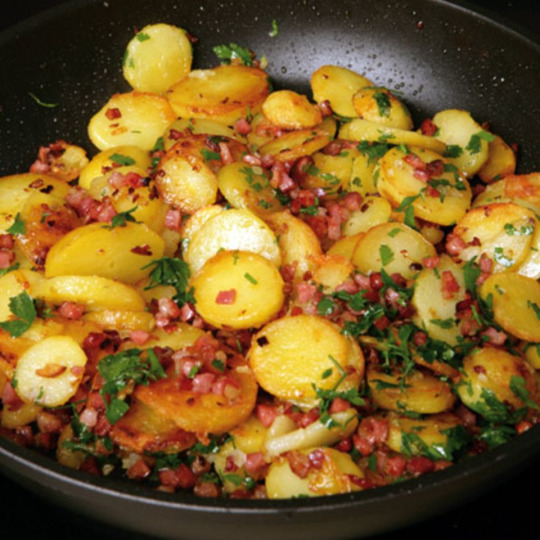
Brezel
Brezeln (pretzels) are baked pastries made from dough and shaped into a symmetrical knot. They are typically seasoned with salt, but can also have toppings such as cheese or seeds.
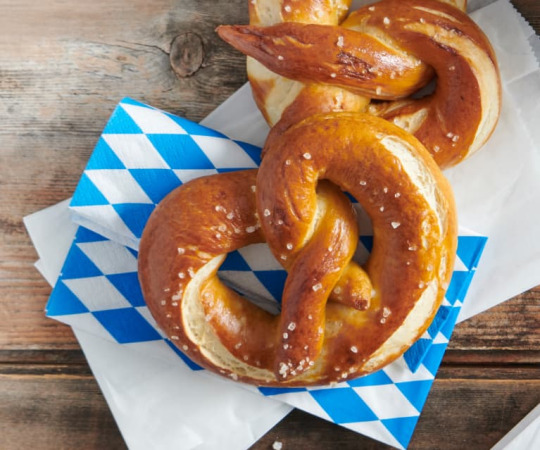
Brot
Brot (bread) comes in many different types, from white wheat bread (Weißbrot) to gray (Graubrot) to black (Schwarzbrot), which is actually dark brown rye bread. Some breads contain both wheat and rye flour and are called Mischbrot. Others have seeds such as linseed and sunflower seeds and are wholegrain (Vollkornbrot). Bread can also be made from spelt (Dinkelbrot), rye (Roggenbrot), or a mix of these with wheat.

Brötchen (bread rolls) are also very common and can be made from the same cereals and seeds as normal bread.
Currywurst
Currywurst is Berlin's most famous dish and consists of a pork sausage with ketchup and curry powder.
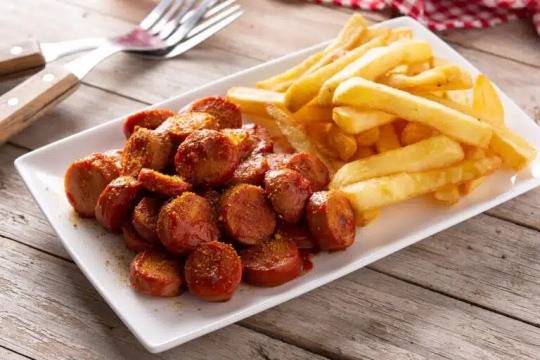
Eierschecke
Eierschecke, whose name is derived from a tripartite piece of clothing, consists of three layers: the bottom one is either a yeast dough or made with baking soda, the middle layer is a cream made of quark, vanilla, butter, egg, sugar, and milk, and the top one is made from eggs, butter, sugar, and vanilla pudding powder. It is a specialty from Saxony and Thuringia.

Fischbrötchen
A Fischbrötchen (fish bread roll) is a sandwich made with various fish, either pickled or fried, and onions, common in northern Germany.

Flammkuchen
Flammkuchen means "pie baked in the flames" and originates from Baden in Baden-Württemberg and the Palatinate in Rhineland-Palatinate. It is similar to a pizza with thin crust covered with crème fraîche, onions, and lardons.

Frikadellen
Frikadellen are flat-bottomed, pan-fried meatballs of minced meat. They are commonly eaten with pasta salad or potatoes, or in a bread roll with mustard.

Himmel und Erde
Himmel und Erde (heaven and earth) is a dish with mashed potatoes, stewed apples and fried blood pudding. Potatoes are also called Erdäpfel (ground apples), so it is a meal made with apples that grow above and under the earth. It is popular in the Rhineland in Rhineland-Palatinate and North Rhine-Westphalia, Westphalia in North Rhine-Westphalia, and Lower Saxony.
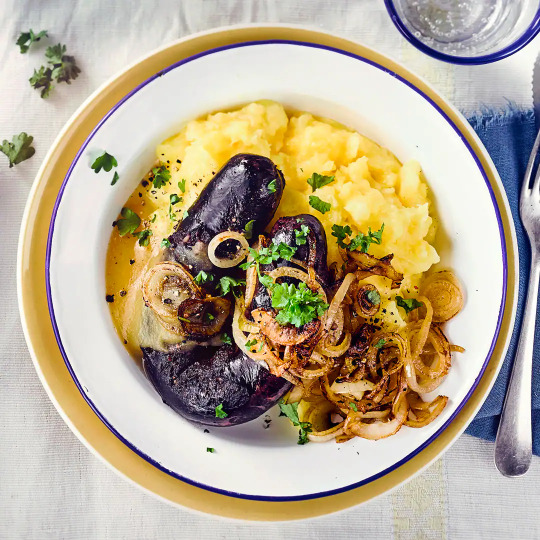
Kirschenmichel
Kirschenmichel is a kind of bread pudding made with cherries and served hot with vanilla sauce. It is typically eaten in Franconia in Bavaria and Thuringia, the Palatinate, Baden-Württemberg, and Hesse.

Klöße/Knödel
These dumplings are known as Klöße in northern, central, and western Germany and Knödel in southern Germany. They are usually made from flour, bread, or potatoes. There are different varieties, including dumplings made of ground liver or breadcrumbs.

Kohlroulade
A Kohlroulade (cabbage roll) consists of cooked cabbage leaves wrapped around a meat filling seasoned with garlic, onion, and spices. Rinderrouladen are similar but consist of bacon and onions wrapped in beef.

Labskaus
Labskaus is a dish made from corned beef, herring, mashed potatoes, and beetroot, served with a fried egg and a pickled cucumber. It is typically eaten in northern Germany.
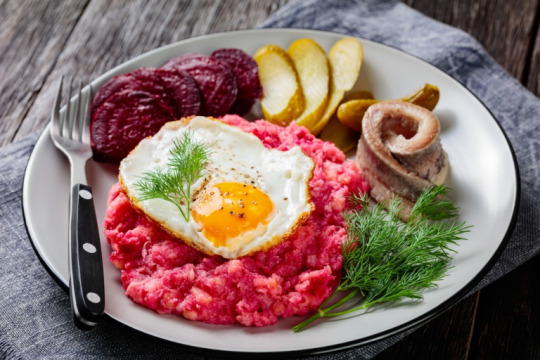
Leberkäse
Leberkäse ("liver-cheese") is eaten in Franconia, Saarland, and Swabia in Bavaria and Baden-Württemberg. It consists of beef, pork, and bacon that are finely ground and then baked as a loaf in a bread pan. It is served with an egg and mashed potatoes.

Leipziger Allerlei
Leipziger Allerlei was invented in Leipzig and consists of a mixture of peas, carrots, green beans, asparagus, morels, and celery. It may also contain broccoli, cauliflower, or corn. It is served with potatoes and a sauce made from crayfish butter, crayfish tails, and semolina dumplings.

Marmorkuchen
Marmorkuchen (marble cake) has a streaked appearance, achieved by lightly blending light and dark batter. It can be a mixture of vanilla and chocolate.

Maultaschen
Maultaschen ("mouth bags") are large meat-filled dumplings typical of Swabian cuisine. They can also be filled with spinach, onions, and spices and can be either served with broth or cut into slices and fried with eggs.

Pfefferpotthast
Pfefferpotthast (boiled meat pepper pot) is a traditional Westphalian stew made with beef, lard, onions, and spices. It is served with boiled potatoes and salad in the summer and pickled cucumbers and beetroot in the winter.
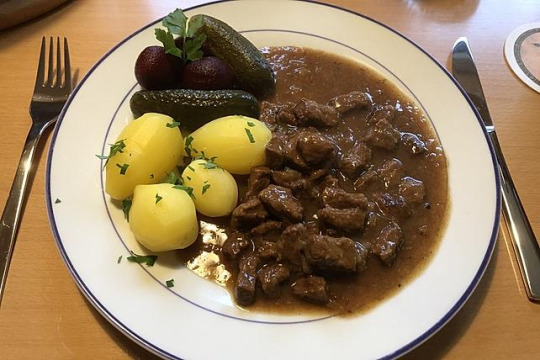
Pinkel mit Grünkohl
It is a dish made from slowly cooked kale served with Pinkel, a salty sausage eaten mainly in Bremen and Lower Saxony.
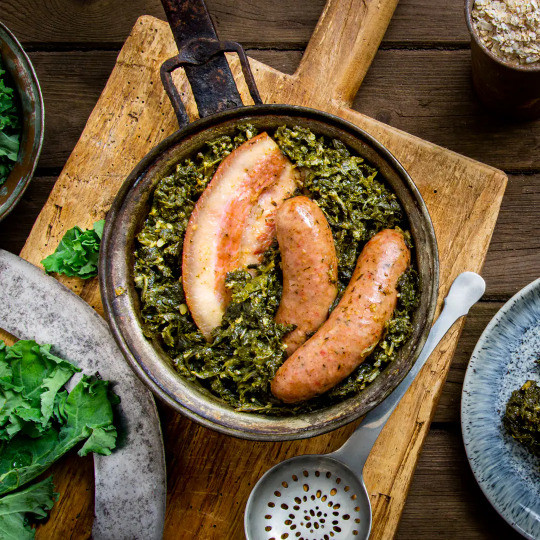
Quarkkäulchen
A Quarkkäulchen ("little quark ball") is a Saxon dish made from quark, mashed boiled potatoes, flour, an egg, and lemon peel. The dough is then baked in the form of a pancake and eaten hot with sugar and cinnamon or with fruit, whipped cream, and vanilla ice cream.

Reibekuchen
These potato pancakes are served with black bread, sugar beet syrup, or stewed apples. They are common in many areas of the country, but the name is characteristic to the Rhineland.

Rollmops
Rollmops ("rolled pug/fat young boy") are pickled herring fillets, rolled around a savory filling, usually consisting of onion and a pickle. It is a specialty from Berlin.

Sauerbraten
Sauerbraten is regarded as the national dish of Germany. It originally comes from the Rhineland and consists of large pieces of beef or horse meat, marinated in a spicy water-vinegar mixture before baking and served with Klöße.
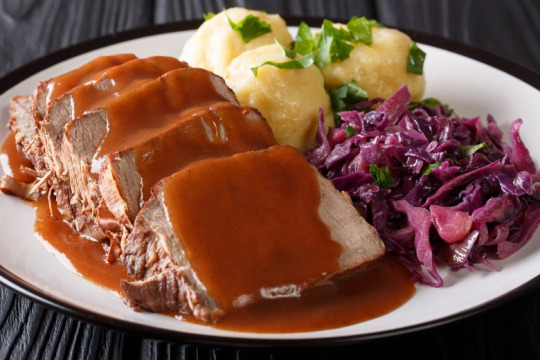
Sauerkraut
Sauerkraut is finely cut raw cabbage fermented by lactic acid bacteria.

Saumagen
Saumagen ("sow's stomach") is popular in the Palatinate and consists of a pork's stomach filled with pork, sausage meat, and potatoes. It is usually served with mashed potatoes or Bratkartoffeln and Sauerkraut.
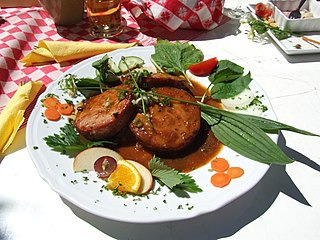
Schnitzel
A Schnitzel is a fried, breaded thin piece of meat, typically pork or beef. Although the most famous one is Wiener Schnitzel (Viennese style), there are other kinds, including Jägerschnitzel, with mushroom sauce; Rahmschnitzel, with cream sauce, and Zigeunerschnitzel, with a sauce made with tomato, bell peppers, and onion.

Schupfnudel
Schupfnudel are thick noodles typical of southern Germany. They are usually made from flour or potatoes and eggs and served with Sauerkraut.
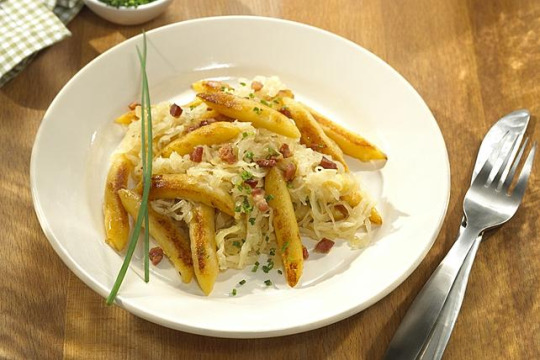
Schwarzsauer
Schwarzsauer ("black sour") is a North German blood soup with spices cooked in vinegar.

Schwarzwälder Kirschtorte
Black forest cake is a chocolate and whipped cream cake with a cherry filling and cherries on top.
Schweinshaxe
Schweinshaxe is a typical Bavarian dish of roasted ham hock served with Sauerkraut. A variation of this dish is known elsewhere as Eisbein ("ice leg"), in which the ham hock is pickled and slightly boiled.
Schwenkbraten
Schwenkbraten is a pork neck steak marinated in spices and onions. It is originally from the Saarland and grilled on a Schwenker, a grill that hangs on a chain over a wood fire.
Spaghettieis
Spaghettieis (spaghetti ice cream) is an ice cream dish made to resemble spaghetti. Vanilla ice cream is extruded through a modified Spätzle press to give it the appearance of spaghetti. It is placed over whipped cream and topped with strawberry sauce to simulate tomato sauce and either coconut flakes, grated almonds, or white chocolate shavings to represent Parmesan cheese.
Spätzle
Spätzle (little sparrow) are hand-made egg noodles, originally from Swabia. They are the main ingredient of several dishes, such as Käsespätzle (Spätzle with cheese) and Linsen mit Spätzle (lentils with Spätzle).
Streuselkuchen
Streuselkuchen ("crumb cake") is made of yeast dough covered with a sweet crumb topping (Streusel). The recipe originated in German Silesia.
47 notes
·
View notes
Text
Anonymous Asks: "What do you think are Jack's, Joseph's, Shaun's, Ian's, Nick's, and Jean's favorite foods and drinks?"

Ooooh I’m gonna do these a lil out of order for Headcanon Reasons~
Content: Food and drink talk

Joseph:
Okay so I know everyone headcanons him as Italian-American, but like… my little Jewish heart likes to think he’s Jewish
Some of his favourite foods are ones he remembers his bubbe making for him before she passed away and he ran away
Her brisket is the thing he misses the most, so soft with just a hint of hot sauce and horseradish. Sandwiched between two slices of freshly baked challah…
The slightly gross bagels and lox she used to buy for him on a Sunday morning
But also he’s a sucker for a greasy burger and slightly soggy fries, a strawberry milkshake on the side
Shitty boxed wine (or manischewitz lmao)
Jack:
So, Sunny Day Jack was meant to be an all-American guy, but this Jack is a weird amalgamation of Jack and Joseph
So, uh, he’s Jewish too now. It’s my house I get to make the rules, and the rules are I project onto characters
Apples may be his favourite snack, but for a meal? Matzo ball soup. It’s got vegetables, protein, carbs… if you make it the day before, you can skim off the schmaltz!
He also loves fruit salads and regular salads, and—no surprise here—blueberry pancakes
Any sort of fruit juice is good for him! He’ll freshly squeeze it himself to make sure there’s not too much sugar
Man loves milk
Shaun:
Shaun is an accomplished man in many respects, but uhhhh… cooking is not one of them
He’s not the worst at it, he can make himself ready meals or boxed mac and cheese or simple dishes
But generally, he kinda prefers to just get food in. Chinese, Thai, and Indian are absolutely his favourites, but he does also like to try new places when he can
He’s a big fan of sandwiches! Any filling, he just loves something he can hold in one hand while he works
As for drinks, he loves a good smoothie. Especially those super healthy green ones full of like kale and spinach and stuff
Shaun’s alcoholic drink of choice is vodka
Ian:
Ian’s a pretty good cook! Not like… professional chef level, but he likes to watch cooking shows
He’s picked up a few things, and he’s learned to cook all of his favourite foods
He makes an absolutely delicious ramen, a very good full English breakfast, and he’s also a decent baker. Pies, cookies, cinnamon rolls of course
Breakfasts are definitely his specialty, especially things that are good for breakfast in bed
He loves strawberry milk, it’s almost silly how excited he gets about it (but also so cute)
He’s a big fan of all types of tea!
Nick:
Now, Ian may be a good cook, but Nick is almost a professional level cook. He’s practiced for years
He’s good enough to make his own new recipes if he knows the basic ingredients needed
He specializes in all types of rice and pasta and bread, all made by hand. Fried rice, coconut rice, carbonara, bolognese, naan, pizza, anything like that
He does love a good pain au chocolat, especially with a hot coffee. It’s his ideal breakfast
When it comes to drinks, he mostly sticks with water and coffee, but sometimes he’ll drink soda
He’s a sucker for lemonade
Jean:
Look, Jean never wanted to be an actor. He wanted to be a baker. It’s why he stuck with the Rory role for so long.
He’s not like… the best at it, just cause he doesn’t have much time to practice
But he definitely loves to eat sweets! Cakes and cookies, macrons and meringues, parfaits and puddings. Anything sweet, he has a major sweet tooth!
Cafe foods and drinks in general are his favourites. Croissants, doughnuts, coffee, tea
He loves a good cup of hot chocolate, with marshmallows and whipped cream
This man loves baileys
#swwsdj#something's wrong with sunny day jack#sdj joseph#sdj jack#sdj shaun#sdj ian#sdj nick#sdj jean#sdj headcanons#18+ only#sunshine
38 notes
·
View notes
Text

“I wish you a Merry Christmass at Home” 2nd mate of the whaleship Arnolda Benjamin Boodry wrote in the margins for his entry on this day in 1852. He consoled himself with his lot with a refrain he wrote often over the years: “But it is not for life if it is for 4 years”. On Christmas eve, he shared where his subconscious was spending its time:

“A pleasant dream about home and loved ones I wish I was there to night I think I should call on some of my friends if it was not to late But there is many a calm, squall, and gale to pass over my devoted head before that day comes.”
Holidays tended to bring out the sentimentality in many whalers who were so long and far from what they felt was home. Here are a handful:
Allen Newman, Edward, 1848

“I wish all my friends A merey Christmus which is more than I anticipate for myself.”
Mary Lawrence, Addison, 1858
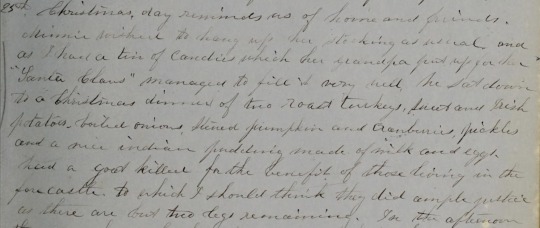
“Christmas Day reminds us of home and friends. Minnie wished to hang up her stocking as usual, and as I had a tin of candies which her grandpa put up for her, “Santa Claus” managed to fill it very well. We sat down to a Christmas dinner of two roast turkeys, sweet and Irish potatoes, boiled onions, stewed pumpkin and cranberries, pickles, and a nice indian pudding made of milk and eggs. Had a goat killed for the benefit of those living in the forecastle, to which, I should think, they did ample justice as there are but two legs remaining.”
Joseph Dias, Ocmulgee, 1847

“Comes with strong breezes from the westward and overcast weather, steering S.E. with all sail set. This day I am 25 years old 25 what and not married yet are like to be shocking. But this is not all I am disapointed in. For I have been keeping Marys cake to celebrate my birth day with and this morning I took it out for the pourpus of eating but when I come to cut it I found it was spoiled a sad disappointment. But what grieves me most is to think I let it spoil after Mary took so much panes with it Oh dear Mary I hope you will not spoil so soon for the want of some one to take care of you.”
John Winslow, Wave, 1852

“Comes with a strong gale of wind from the E.ward this day My Wife is 26 years old if she is living and has got a poor sailor for a husband but it is not the worst for her for that May she live to enjoy many more years of Life and may they prove to be far happier than those that are past”
[Dec 26th]

“O if I could make 250 dollars this voyage I would not go to sea any more for it is a dogs life and sometimes when I think of the comforts of my home with my Wife and children I almost resolve never to go to sea again let me get a home of my own and I will stay by it.”
J.T. Langdon, St Peter, 1849

“The first part calm not a breath of air ruffled the face of the stormy deep. But with an ever rolling motion rocks our old ship like a vast cradle and the surface of the deep is like a vast mirror reflecting objects on its surface The first part ends Christmas and how many melancholy reflections come around unbidden and unasked for One year ago I was at home enjoying every pleasure that heart could wish friends to cheer and schoolmates to greet with a merry Christmas but now I am far away on the stormy ocean Many thousand miles intervene between this and my once happy Home”
John Martin, Lucy Ann, 1841

“As fine a day as we have had since we left the Capes of Delaware. The Watch on deck was employed in breaking out from the hold, bread, water, vinegar & other stores. We had Turtle Sea Pie for dinner. Take it altogether we spent a merry Christmas & more to my satisfaction than many a one I spent on shore.”
Benjamin Bourne, Annawann II, 1859

“[in the margins, alongside a stamp of a whale’s flukes] This Whale aught to have been saved - stove the boat
Wish All a Mary Christmas
Begins with a strong wind Bark steering S at 3 pm wind shifted to the Estrd a heavey rain squall took in sail to a close reef Main Topsail & staysails luffed to the wind heading SSE. Lat part at 9am saw a large sperm whale going slow into the SW so ends this day.
[With an addendum on Jan 29th, 1899]
I thought I was having a hard time 40 years ago but it was the best of my life.
Silliman Ives, Sunbeam, 1868
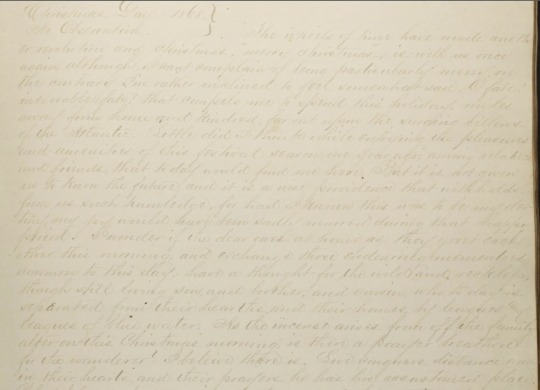
“The wheels of time have made another revolution and Christmas “Merry Christmas” is with us once again, although I can’t complain of being particularly merry, on the contrary I am rather inclined to feel somewhat sad. O Fate! Inexorable fate! that compels me to spend this holiday miles away from home and kindred, far out upon the surging billows of the Atlantic. Little did I think while enjoying the pleasures and amenities of this festival season one year ago among relatives and friends, that to day would find me here. But it is not given us to know the future, and it is a wise providence that withholds from us such knowledge, for had I known this was to be my destiny, any joy would have been sadly marred during that happy period. I wonder if the dear ones at home as they greet each other this morning, and exchange those endearing mementos common to this day, have a thought for their wild and reckless though still loving son, and brother, and cousin, who to day is separated from their hearths and homes by leagues and leagues of blue water. As the incense arises from off the family altar on this Christmas morning, is there a prayer breathed for the wanderer? I believe there is. Love conquers distance and in their hearts and their prayers he has his accustomed place.”
#long post //#awhalin#GOT KINDA SAD COMPILING THESE….love all u….#I’m fine and used to spending holidays alone but there is somethin about….goin through the journals of these lads also spendin them alone#LOVE ALL U LADS SO MUCH….
65 notes
·
View notes
Text
In the 1950s and ’60s, women baked cakes in the abandoned ammunition boxes left behind by British troops in the villages of Nagaland, a state in northeast India. The Naga writer Easterine Kire recalls how wives of Christian missionaries taught English and cake-baking to young girls, including her mother. While they didn’t really pick up the language, the tradition of baking cakes was passed down “from mother to daughter and from daughter to granddaughter.” It was the men who thought to repurpose the boxes — they were airtight, preserved heat well and fit perfectly over the wood fire. Since they had no temperature controls, the baker had to sit by the fire, constantly stoking it and eventually reducing it to embers. The timing had to be perfect: A minute too soon or too late could alter the fate of the cake. The boxes eventually ended up becoming part of a family’s heirloom until electric ovens became commonplace.
In the opposite corner of India, in Kerala in the deep south, several bakeries trace their history to the Mambally Royal Biscuit Factory in Thalassery, established in the late 19th century. Its founder, Mambally Bapu, is said to have baked India’s first Christmas cake. Bapu had trained as a baker in Burma (now Myanmar) to make cookies, bread and buns. When he set up shop in 1880, he made 140 varieties of biscuits. Three years later, the Scotsman Murdoch Brown, an East India Company spice planter, shared a sample of an imported Christmas plum pudding. Wanting to re-create this traditional recipe but unable to source French brandy, Bapu improvised with a local brew made from fermented cashew apples and bananas. He added some cocoa and — voila — the Indian Christmas cake was born.
The beauty of the Indian Christmas cake lies in its local variations. The Allahabadi version from north India features petha (candied ash gourd or white pumpkin) and ghee instead of butter, along with a generous helping of orange marmalade. Maharashtrians, in west India, add chironji, also known as cuddapah almonds. The black cake in Goa derives its color from a dark caramel sauce. In the south, in Kerala and Tamil Nadu, cashew nuts are added to the mix. The Indian version is “a close cousin” of British plum pudding, but it has no lard and is not steamed. “Indian Christians add a generous dose of hot spices such as nutmeg, cinnamon, cloves and shahi zeera (royal cumin seeds), roasted dry and then ground and added, also referred to as ‘cake masala,’” writes Jaya Bhattacharji Rose, an Indian publishing consultant, in “Indian Christmas,” an anthology of personal essays, poems, hymns and recipes.
“Our Christmas cakes reflect how India celebrates Christmas: with its own regional flair, its own flavor. Some elements are the same almost everywhere; others differ widely. What binds them together is that they are all, in their way, a celebration of the most exuberant festival in the Christian calendar,” writes Madhulika Liddle, co-editor of the anthology. Reading the book feels like a celebration in itself and makes one realize that Christians in India are as diverse as India, with Syrian Christians, Catholics, Baptists, Anglicans, Methodists, Lutherans and others. Though Christians make up just 2% of India’s population, this equates to some 28 million people.
Christianity came to India in waves. It is believed that Thomas the Apostle arrived in present-day Kerala in 52 BCE and built the first church. Syrian Christians believe he died in what is now Chennai in Tamil Nadu. San Thome Basilica stands where some of his remains were buried. Toward the end of the 15th century, the Portuguese explorer Vasco da Gama landed on Indian shores, followed by others, paving the way for Portuguese colonies in the region. Christian missionaries, who set up Western educational institutes, spread the religion further. The trend continued under the British Empire.
What is unique about India is the “indigenization of Christmas,” notes Liddle. It can be seen in the regional dishes prepared for Christmas feasts and celebrations. Duck curry with appams (rice pancakes) is popular in Kerala, while Nagaland prefers pork curries, rich with chilies and bamboo shoots. In Goa, dishes with Portuguese origins, such as sausage pulao, sorpotel and xacuti, adorn the tables. Biryanis, curries and shami kababs are devoured across north India.
The same regional diversity can be seen in Christmas snacks. “East Indians,” a Christian community in Mumbai described as such for their close ties to the East India Company, fill their plates with milk creams, mawa-filled karanjis (pastry puffs filled with dried whole milk), walnut fudge, guava cheese and kulkuls (sweet fried dough curls). In Goa, a platter of confectioneries called kuswar is served, including kormolas, gons, doce and bolinhas, made with ingredients ranging from coconut to Bengal gram, a yellow lentil. In Kerala, rose cookies are popular. Common across north Indian Christian households are shakkarpara, a sweet fried dough, covered in syrup; namakpara, a savory fried dough studded with cumin seeds; gujiyas, crisp pastries with a sweetened mix of semolina, raisins and nuts; and baajre ki tikiyas, thin patties made from pearl millet flour sweetened with jaggery, an unrefined sugar.
Liddle, who used to spend the festival at her ancestral home in the north Indian town of Saharanpur, also tells us about a lesser-known variation of the Christmas cake: cake ki roti. (In Hindi, “roti” means “flatbread.”) Like most communities in India, many Christian families in north India buy the ingredients for the Christmas cake themselves and take them to a baker who will prepare it. Bakers used to make the Christmas cake by the quintal (220 pounds) or more, and cake ki roti was a byproduct of that large-scale baking. The leftover Christmas cake batter was “not enough for an entire tin, not so little that it can be thrown away,” Liddle explained. So the baker would add flour and make a dough out of it. “It would be shaped into a large, flat disc and baked till it was golden and biscuity,” she said. The resulting cake ki roti may have “stray bits of orange peel or candied fruit, a tiny piece of nut here or there, a faint whiff of the spices … It was not even the ghost of the cake. A mere memory, a hint of Christmas cake.” Since cake ki roti was considered “too pedestrian,” it wasn’t served to the guests. Instead, it would be reserved until the New Year and eaten only after all the other snacks were gone.
Jerry Pinto, co-editor and contributor to “Indian Christmas,” recalled his childhood Christmases in Mumbai. There may not have been much snow in this tropical city, but wintry scenes of London and New York adorned festive cards and storybooks, and children would decorate the casuarina tree with cotton balls, assuming it to be pine. The mood would be set with an old Jim Reeves album featuring “White Christmas.” “Where do old songs from the U.S. go to die? They go to Goan Roman Catholic homes and parties,” quipped Pinto. Raisins would be soaked in rum in October, and cakes baked at an Iranian bakery. Every year, there was a debate about whether marzipan should be made with or without almond skins. The “good stuff” meant milk creams and cake slices with luscious raisins, while rose cookies and the neoris (sweet dumplings made of maida or flour and stuffed with coconut, sugar, poppy seeds, cardamom and almonds) were just plate-fillers.
The feasting is accompanied by midnight mass, communal decorations and choral music, with carols sung in Punjabi, Tamil, Hindi, Munda, Khariya, Mizo tawng, as well as English. “One of our favorite carols was a Punjabi one, which we always sang with great gusto: ‘Ajj apna roop vataake / Aaya Eesa yaar saade paas’ [‘Today, having changed His form / Jesus comes to us, friend’],” Liddle remembered.
Starting as early as October, it would not be unusual to hear Christmas classics by Boney M., ABBA and Reeves in Nagaland’s Khyoubu village. “The post-harvest life of the villagers is usually a restful period, mostly spent in a recreational mood until the next cycle of agricultural activities begins in the new year,” wrote Veio Pou, who grew up in Nagaland.
“Christmas is a time when invitations are not needed. Friends can land … at each other’s homes any time on Christmas Eve to celebrate. … The nightly silence is broken, and the air rings with Christmas carols and soul, jazz and rock music. Nearly every fourth person in Shillong plays the guitar, so there’s always music, and since nearly everyone sings, it’s also a time to sing along, laugh and be merry,” wrote Patricia Mukhim, editor of Shillong Times, a local newspaper in the northeastern state of Meghalaya.
Neighborhoods in areas with Christian populations, like Goa and Kerala, are lit up weeks in advance with fairy lights, paper lanterns and Christmas stars. In Mizoram’s capital of Aizawl, local authorities hold a competition every Christmas for the best-decorated neighborhood, with a generous prize of 500,000 rupees ($6,000) awarded to the winner. This event is gradually becoming a tourist attraction.
Rural India has its own norms and traditions. In the villages of the Chhota Nagpur region, mango leaves, marigolds and paper streamers decorate homes, and locally available sal or mango trees are decorated instead of the traditional evergreen conifer. The editor Elizabeth Kuruvilla recalled that her mother had stars made of bamboo at her childhood home in Edathua, a village in Kerala’s Alappuzha district. The renowned Goan writer Damodar Mauzo, who grew up in a Hindu household, said his family participates in many aspects of the Christmas celebrations in the village, including hanging a star in the “balcao” (“balcony”), making a crib and attending midnight mass.
In the Anglo-Indian enclave of Bow Barracks in Kolkata, Santa Claus comes to the Christmas street party in a rickshaw — the common form of public transport in South Asia. “Kolkata’s Bengali and non-Bengali revelers now throng the street, lined by two rows of red-brick terrace apartment buildings, to witness the music and dance and to buy the home-brewed sweet wine and Christmas cake that some of the Anglo-Indian families residing there make,” wrote the journalist Nazes Afroz. Bow Barracks was built to house the Allied forces stationed in Kolkata during World War I, after which they were rented out to the city’s Christian families.
Kolkata also is home to a tiny community of about 100 Armenian Christians, who celebrate Christmas on Jan. 6, in line with the Armenian Apostolic Church. Many break their weeklong fast at the Christmas Eve dinner, known as “Khetum.” The celebration begins with an afternoon mass on Christmas Eve followed by a home blessing ceremony to protect people from misfortune, held at the Armenian College and Philanthropic Society, an important institution for the community. The Khetum arranged for the staff members and students includes a customary pilaf with raisins and fish and anoush abour, an Armenian Christmas pudding made with wheat, berries and dried apricots, among other dishes. The Christmas lunch also includes traditional Armenian dishes such as dolma (ground meat and spices stuffed into grape leaves) and harissa, a porridge-like stew made with chicken, served with a garnish of butter and sprinkled ground cumin.
“Missionaries to Indian shores, whether St. Thomas or later evangelists from Portugal, France, Britain or wherever, brought us the religion; we adopted the faith but reserved for ourselves the right to decide how we’d celebrate its festivals,” Liddle wrote. “We translated the Bible into our languages. We translated their hymns and composed many of our own. We built churches which we at times decorated in our own much-loved ways.”
43 notes
·
View notes
Text
I think the worst food I ate in Scotland and England was the kind of overdone gastropub food that’s also widely available in America and also bad here. Like burgers with too much stuff on them. English breakfast wouldn’t be bad except that it’s too wet (I liked the black pudding though). Nando’s is good. Fish and chips and meat pies and soup of the day with crusty bread is good. Italian is great and Indian basically the best ever. I like mushy peas but honestly I’m just always a slut for peas.
6 notes
·
View notes
Text
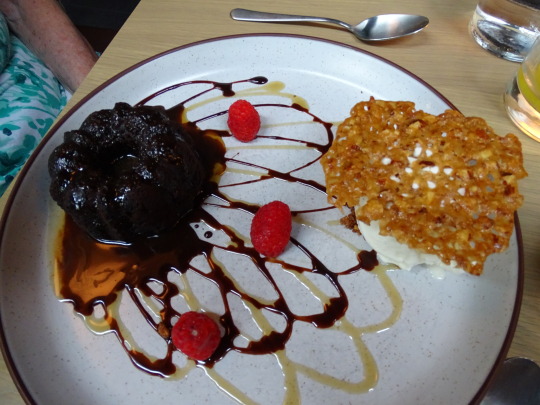
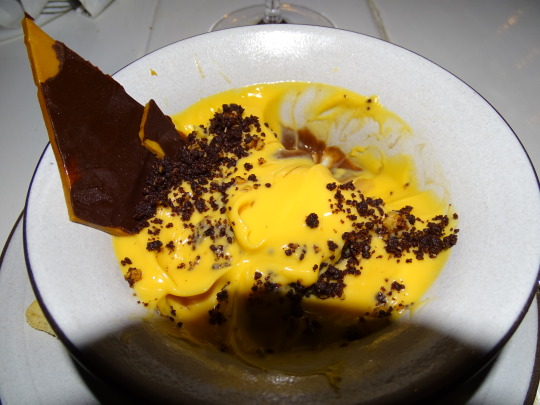

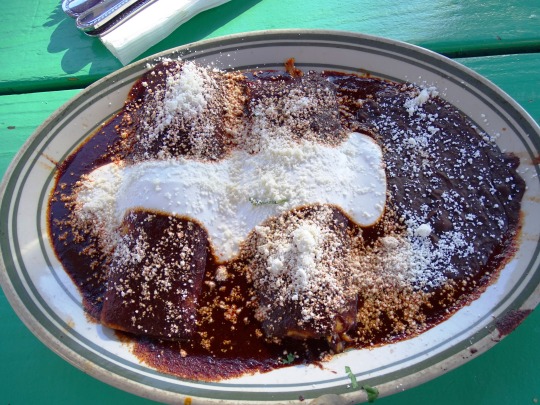
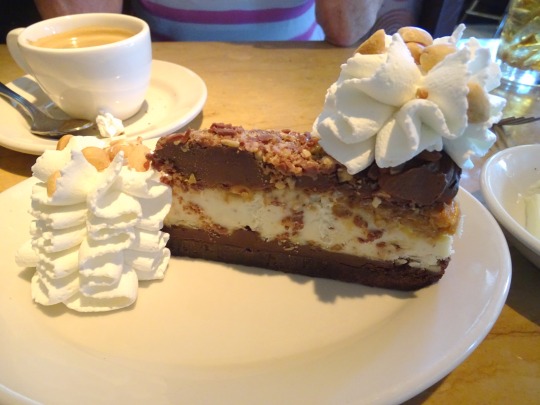

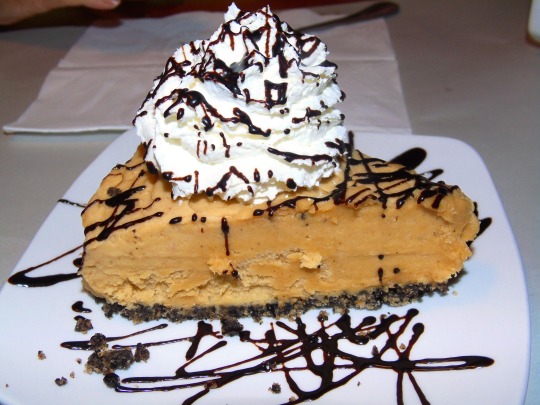




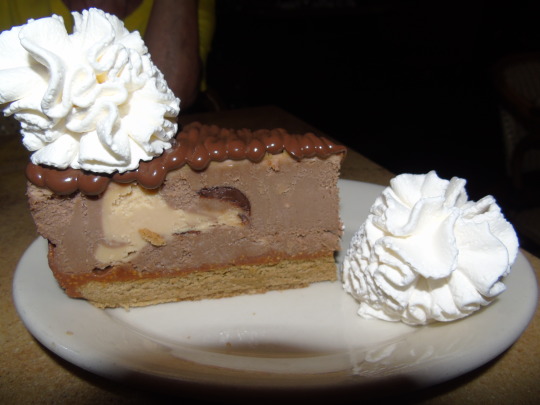
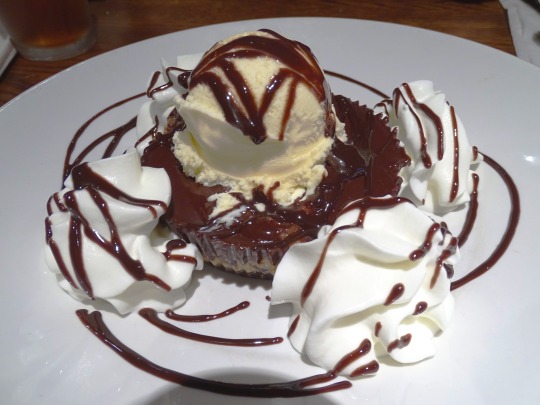
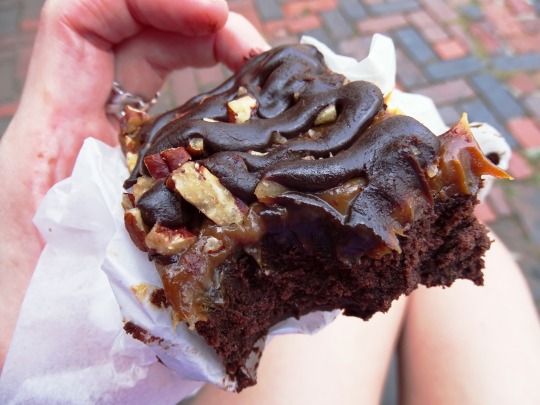
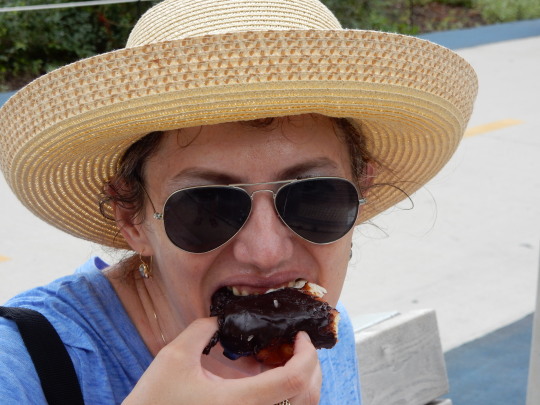

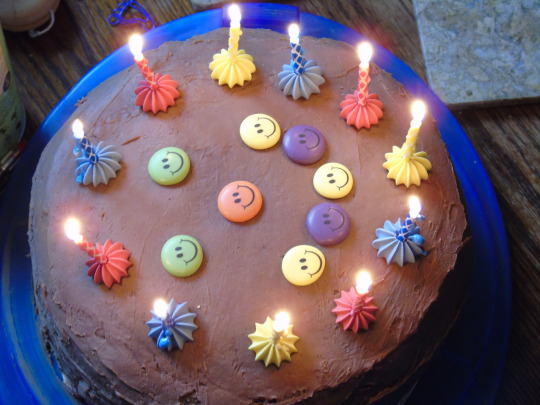
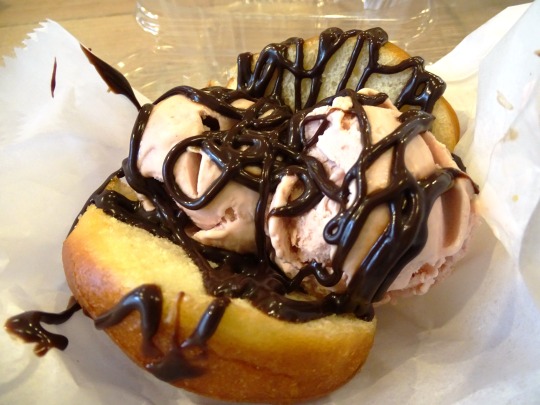
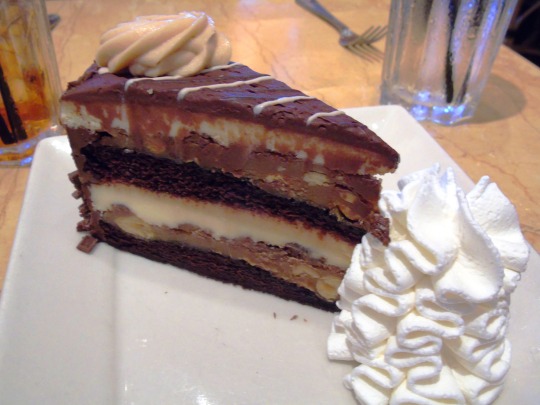
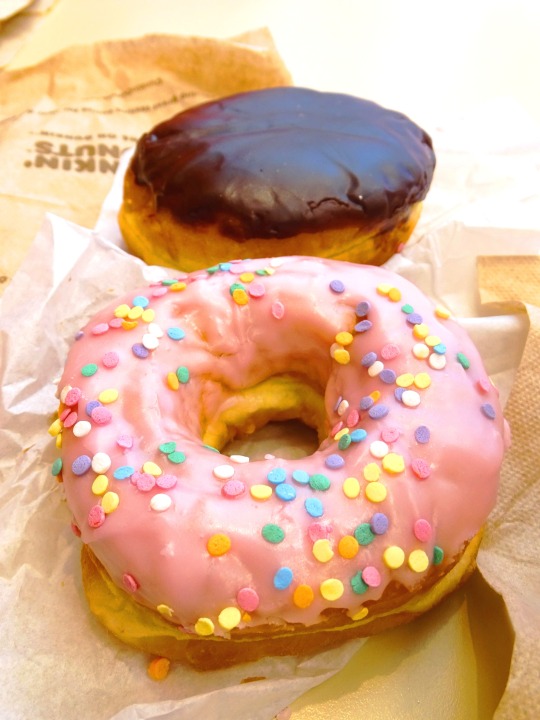




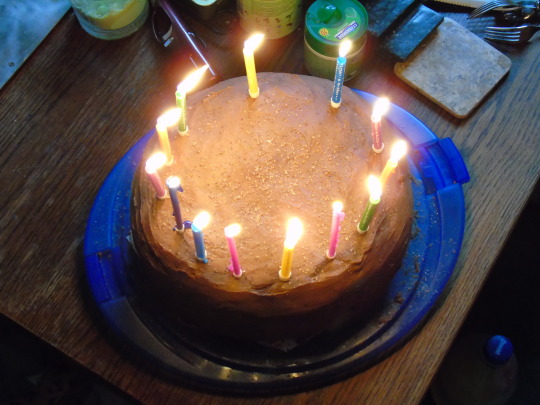
National Chocolate Covered Anything Day
Indulge in a chocolate fountain or fondue to dunk any treats you fancy or drizzle your favorite desserts in delicious sauce and syrup.
Chocolate, a candy loved by both children and adults alike. But how much can it go on? What edible creations can molten chocolate create? Where in the world are certain chocolate dishes made a favorite staple? Well, in order to find the answers to all those questions, we must do a time-hop into the past, for this is the search of the history of Chocolate Covered Everything Day!
Learn about Chocolate Covered In Anything Day
Who doesn’t love chocolate? It’s creamy, sweet, and delicious! While we can all eat chocolate on its own, it is fun to combine chocolate with other ingredients as well! A lot of people love strawberries dipped into chocolate; a real classic. Or, how about some chocolate pretzels? There are plenty of weird and wonderful ideas you can try as well, such as dipping French fries into chocolate ice cream. Hey, don’t knock it until you have tried it! If you have ever wondered what something would taste like in chocolate, today is the perfect opportunity for you to find out.
History of Chocolate Covered Everything Day
We all know and love the dark and sweet bricks called chocolate, we even melt it down and put on our ice cream! When was this delectable treat created? The history of chocolate begins in Mesoamerica. Fermented beverages made from chocolate date back to 1900 BC. The Aztecs believed that cacao seeds were the gift of Quetzalcoatl, the god of wisdom, and the seeds once had so much value that they were used as a form of currency. After chocolate’s arrival in Europe from oversea expeditions in the sixteenth century, sugar was added to it and it became popular throughout all of Europe, first among the ruling classes of the European societies, and then among the common people. Jose de Acosta, a Spanish missionary who lived in Peru and then Mexico in the later 16th century, described its use more generally.
Loathsome to such as are not acquainted with it, having a scum or froth that is very unpleasant taste. Yet it is a drink very much esteemed among the Indians, wherewith they feast noble men who pass through their country. The Spaniards, both men and women that are accustomed to the country are very greedy of this Chocolate. They say they make diverse sorts of it, some hot, some cold, and some temperate, and put therein much of that “chili”; yea, they make paste thereof, the which they say is good for the stomach and against the catarrh.
How to celebrate Chocolate Covered Everything Day
To celebrate the day where we coat everything we can in chocolate, we go out and find an affordable mini chocolate fountain, and then we buy whatever we like to go with our chocolate, take it home and set it up, and then enjoy the chocolate covered foods in the comfort of our own home, enjoying it any time we want! We can also celebrate by buying chocolate syrup, heating it up in a bowl and have a bowl of ice cream with a hot chocolate syrup topping.
There are lots of great chocolate desserts you can make on this day as well! We all deserve a treat now and again, and what better sweet treat than a chocolate-based dessert? From sticky toffee pudding to dark chocolate fondant, we take a look at the best desserts for chocolate lovers.
Let’s start with a Chocolate Sticky Toffee Pudding. This is a delicious traditional English dessert with a chocolate twist. When done correctly, sticky toffee features a rich moist sponge that is topped in a thick and indulgent toffee sauce. It is served with a scoop of vanilla ice cream. The coolness of the ice cream against the warmth of the toffee is an exquisite combination.
How about some Chocolate Bread and Butter Pudding? We recommend pairing the bread and butter pudding with a tasty rum banana ice cream. It’s comforting, creamy, and delicious.
You will struggle to find a dessert as decadent and indulgent as Dark Chocolate Fondant. You need just the right amount of gooeyness in the middle. The dessert is usually finished offer with a smooth and refreshing vanilla ice cream and a thick salted caramel sauce. Prepare for your taste buds to be sent into overdrive.
Finally, do you feel like being adventurous? How about some Chilli Spiced Chocolate Cake? Chilli and chocolate are two ingredients you wouldn’t expect to work well together but they make a delicious pairing. It’s not simply a case of making chocolate spicy. Both ingredients have real, varied fruit flavours and so it’s all about pairing them in a complementary manner, which is what you can do with a Chilli Spiced Chocolate Cake. Take this luxurious dessert and give it a contemporary edge by adding chilli, which gives a pleasant kick that will warm the back of your throat.
All in all, if you are a lover of chocolate sweets, you can rest assured that you will be more than happy with one of the four delicious desserts that have been mentioned! There are plenty of other recipes that you can try on National Chocolate Covered Anything Day!
Aside from making your own desserts, National Chocolate Covered Anything Day presents you with a good opportunity to support a local chocolatier. With the increase in the production of commercial chocolate, a lot of people overlook just how delicate and difficult the art of making chocolate can be! So, why not support your local chocolatier and let them know that you are amazed by their incredible work?
Source
#Sticky Toffee Chocolate Pudding#Confetti Donut#Chiapaneco Mole Chicken Enchiladas#Fried Cheesecake#dessert#food#USA#Chocolate Tuxedo Cream Cheesecake#Donut Ice Cream Sandwich#Boston Cream Donut#Reese's Peanut Butter Chocolate Cake Cheesecake#Strawberry Donut#CHOCOLATE HAZELNUT CRUNCH CHEESECAKE#Mole Poblano Paloma#entrée#whipped cream#Chocolate Peanut Butter Cup a la Mode#Chocolate Thunder from Down Under#National Chocolate Covered Anything Day#16 December#original photography#NationalChocolateCoveredAnythingDay#I only eat Swiss chocolate#Swiss chocolate is the best#Banana Split
2 notes
·
View notes